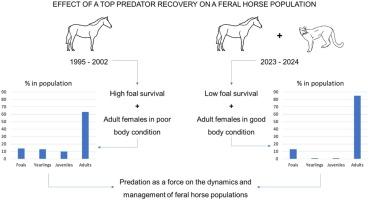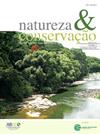The comeback of a top predator and its effects on a population of feral horses
IF 3.5
2区 环境科学与生态学
Q1 BIODIVERSITY CONSERVATION
引用次数: 0
Abstract
The absence of top predators can lead to significant ecological consequences, especially in association with changes in bottom-up ecosystem regulation. In the context of biological invasions, the enemy release hypothesis explains how invasive alien species can reach high densities in the absence of natural antagonists, often leading to negative effects on biodiversity and ecosystem services. Feral equids frequently reach problematic densities in natural environments, where their management faces operational and communication challenges. In this study, we evaluated the impact of puma (Puma concolor) presence on the demography of a feral horse (Equus caballus) population in an Argentinian grassland nature reserve. We compared periods with (2023–2024) and without predation (1995–2002). Foal survival was significantly lower in 2023–2024, while adult survival increased compared to 1995–2002. These changes, coupled with direct evidence of puma predation on young horse carcasses, suggest that pumas are affecting population growth rates by reducing recruitment, and may limit population size. Concomitantly, mean female body condition improved in 2023–2024, suggesting that the loss of foals to predation may reduce lactation-related energy costs. These findings suggest that pumas could play an important role in the dynamics of feral horse populations, marking the first documented case of such a regulation in South America. Incorporating predator activity into management strategies could reduce the need for direct interventions, offering a more sustainable approach to controlling the ecological impacts of feral horse populations.

顶级掠食者的回归及其对野马种群的影响
顶级捕食者的缺失可能导致重大的生态后果,特别是与自下而上的生态系统调节的变化有关。在生物入侵的背景下,敌人释放假说解释了外来入侵物种如何在没有天然拮抗剂的情况下达到高密度,往往导致对生物多样性和生态系统服务的负面影响。野生马科动物在自然环境中经常达到有问题的密度,它们的管理面临着操作和沟通方面的挑战。在这项研究中,我们评估了美洲狮(puma concolor)的存在对阿根廷草原自然保护区野马(Equus caballus)种群的人口统计学影响。我们比较了有(2023-2024)和没有捕食(1995-2002)的时期。2023-2024年马驹存活率显著降低,而成年马驹存活率较1995-2002年有所增加。这些变化,再加上美洲狮捕食幼马尸体的直接证据,表明美洲狮通过减少招募来影响种群增长率,并可能限制种群规模。与此同时,2023-2024年雌马的平均身体状况有所改善,这表明因捕食而失去马驹可能会降低与哺乳相关的能量消耗。这些发现表明,美洲狮可能在野马种群的动态中发挥重要作用,这是南美洲首次记录在案的此类监管案例。将捕食者活动纳入管理策略可以减少对直接干预的需求,为控制野马种群的生态影响提供更可持续的方法。
本文章由计算机程序翻译,如有差异,请以英文原文为准。
求助全文
约1分钟内获得全文
求助全文
来源期刊

Perspectives in Ecology and Conservation
Environmental Science-Nature and Landscape Conservation
CiteScore
7.80
自引率
4.30%
发文量
46
审稿时长
59 days
期刊介绍:
Perspectives in Ecology and Conservation (PECON) is a scientific journal devoted to improving theoretical and conceptual aspects of conservation science. It has the main purpose of communicating new research and advances to different actors of society, including researchers, conservationists, practitioners, and policymakers. Perspectives in Ecology and Conservation publishes original papers on biodiversity conservation and restoration, on the main drivers affecting native ecosystems, and on nature’s benefits to people and human wellbeing. This scope includes studies on biodiversity patterns, the effects of habitat loss, fragmentation, biological invasion and climate change on biodiversity, conservation genetics, spatial conservation planning, ecosystem management, ecosystem services, sustainability and resilience of socio-ecological systems, conservation policy, among others.
 求助内容:
求助内容: 应助结果提醒方式:
应助结果提醒方式:


